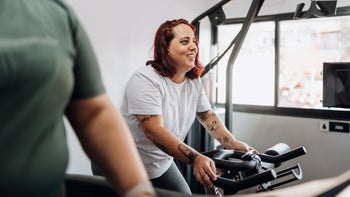
6 Exercises for Anterior Pelvic Tilt
Key takeaways:
Tight hip flexors and weak glutes and abdominals can cause a muscle imbalance that pulls your pelvis forward. This anterior pelvic tilt may lead to low back, hip, and knee pain.
Sitting for long periods, being pregnant, and wearing high heels can cause an anterior pelvic tilt.
Exercises for anterior pelvic tilt should stretch your hip flexors and strengthen your glutes, hamstrings, and core. These moves can help keep your pelvis in the correct alignment.
Table of contents

If you spend a lot of time sitting throughout the day, there's a good chance that you could benefit from doing exercises for an anterior pelvic tilt. These exercises can help address muscle imbalances in your hip area, which can negatively impact your posture and even lead to muscle pain.
An anterior pelvic tilt refers to the way your pelvis is rotated. Instead of sitting in a neutral position, your pelvis is rotated forward. Your lumbar spine (lower back) has a natural inward curve. But an anterior pelvic tilt causes it to curve inward more than it should.
What causes anterior pelvic tilt?
Muscle imbalances can pull your pelvis forward into an anterior pelvic tilt. The muscles in front (the hip flexors) get tight, while the muscles in the back (your glutes, along with your abdominals) become weak. This creates a perfect storm that pulls your pelvis out of alignment.
Search and compare options
This can happen for several reasons, including:
Sitting for long periods
Inactivity
Wearing high heels for long periods
Genetics
Research has found that up to 75% of females and 85% of males have an anterior pelvic tilt. For some people, it causes no issues. For others, it can lead to symptoms that include:
Sacroiliac pain
Poor posture (with back and head curved forward)
Hip and knee pain
Protruding belly
What are the best exercises for anterior pelvic tilt?
Correcting muscle imbalances by stretching the tight muscles and strengthening the weak muscles may help correct an anterior pelvic tilt. A 2020 systematic review looked at four studies that showed a reduction in anterior tilt and improvement in pain with conservative treatment, like exercise. However, researchers pointed out that more high-quality studies with larger sample sizes and a control group are needed.
Staying active throughout the day will also help. If you sit for long periods, try to get up at least once every hour. Take a few minutes to walk around or do some quick stretches. You should also follow a regular exercise routine throughout the week. It should include aerobic exercises and strength training.
Try to do the following six exercises at least three times a week. These stretches should be done after a warmup or after you’re finished with your regular exercise routine.
Read more like this
Explore these related articles, suggested for readers like you.
1. Kneeling hip flexor stretch
The kneeling hip flexor stretch increases flexibility in the muscles at the front of your hip.
Step 1: Kneel down on your right knee. Bend your left leg and place it in front of you with the foot flat on the floor.
Step 2: Place a cushion under your right knee, as needed.
Step 3: Keeping your trunk straight, push your hips forward. You’ll feel a stretch along the front of your thigh and hip.
Step 4: Hold for 15 to 30 seconds.
Step 5: Repeat 3 to 5 times.
Step 6: Repeat on the other side.
2. Pelvic tilt
The pelvic tilt exercise strengthens your abdominal muscles, which are often weak when you have an anterior pelvic tilt. It also stretches your lower back muscles. And it helps to shift your pelvis into a better position.
Step 1: Lie on your back with your knees bent and your feet flat on the floor.
Step 2: Tighten your abdominal muscles by pressing your back into the floor. It will feel like your belly button is moving back.
Step 3: Hold for 5 seconds and then relax.
Step 4: Repeat 10 to 15 times.
Step 5: Perform 2 to 3 sets.
3. Bridge
The bridge exercise is a move that increases strength in your glutes, hamstrings, and core. All these muscles can become weak with an anterior pelvic tilt. As a bonus, it also stretches out the muscles in the front of your hips.
Step 1: Lie on your back with your knees bent and your feet flat on the floor.
Step 2: Place your arms by your side with your palms up.
Step 3: Push your heels into the floor as you lift your hips up off the floor.
Step 4: Continue lifting until your body forms a straight line.
Step 5: Hold for a few seconds, squeezing your glutes at the top.
Step 6: Lower yourself back down into the starting position.
Step 7: Repeat 2 to 3 sets of 12 to 15 repetitions.
4. Donkey kicks
The donkey kick exercise works the glute muscles, along with your core.
Step 1: Start on all fours, with your hands under your shoulders and your knees under your hips.
Step 2: Tighten your core as you lift your right knee behind you, keeping it bent at a 90-degree angle.
Step 3: Keeping your knee bent, lift your foot up toward the ceiling and feel your glutes contract.
Step 4: Bring your leg back down to the starting position.
Step 5: Repeat with the same leg. Kick your right knee behind you and up toward the ceiling for 12 to 15 reps.
Step 6: Repeat on the other leg.
Step 7: Complete 2 to 3 sets on each leg.
5. Squats
The squat is a fabulous lower-body exercise that strengthens your glutes, hamstrings, quads, calves, and even your core.
Step 1: Stand with your feet slightly wider than shoulder-width apart, with your toes turned slightly out.
Step 2: Lower yourself down into a squat, pushing your hips back.
Step 3: Try to lower yourself until your thighs are parallel to the ground. If you can’t go that far, go down as far as you comfortably can.
Step 4: Push through your heels as you come back up to a standing position.
Step 5: Repeat 12 to 15 times for 2 to 3 sets.
6. High planks
The plank exercise strengthens your entire core. This helps support your pelvis and promote normal alignment.
Step 1: Assume a high push-up position, with your hands shoulder-width apart and your legs straight behind you.
Step 2: Tighten your stomach and keep your body in a straight line. Don’t let your midsection sag down or stick up in the air.
Step 3: Keep your neck in a neutral alignment, looking down at the floor.
Step 4: Hold this position for up to 1 minute. You can start with 15 seconds and gradually work your way up to 60 seconds.
When should you see a healthcare professional for anterior pelvic tilt?
If you start having pain, it’s a good idea to see a healthcare professional. If you have a job where you sit throughout the day and you’re experiencing some mild low back pain, try the exercises above for a few weeks. Your pain should start to improve within 3 to 4 weeks of regular exercise.
It’s a good idea to talk to a healthcare professional about the best treatment options for you if:
Your pain gets worse or doesn’t get better
You have low back pain that worsens with pelvic tilt exercise
You start experiencing numbness or tingling down your legs
You have a larger body size and you’re experiencing anterior tilt
You’re experiencing pelvic tilt due to pregnancy
The bottom line
An anterior pelvic tilt can affect your posture, which puts you at risk for low back, hip, and knee pain. Sitting all day, along with being pregnant or having a larger body size, can all cause an anterior pelvic tilt. Even wearing high heels can pull your pelvis out of alignment. Addressing muscle imbalances can help treat this condition. Exercises that stretch your hip flexors and strengthen your glutes, hamstrings, and core can help keep your pelvis in proper alignment.
Why trust our experts?



References
Austin, Denise. (2018). Do it right - high plank | LifeFit 360 | Denise Austin [video]. YouTube.
Bhutto, Mazhar Ali, et al. (2021). Influence of overweight and obesity on pelvic tilt, q-angle, and foot posture in both genders. Pakistan Journal of Medical & Health Sciences.
Columbia University Irving Medical Center. (n.d.). Hip flexor stretch (kneeling).
Columbia University Irving Medical Center. (n.d.). Pelvic tilt exercise.
Falk Brekke, A., et al. (2020). Non-surgical interventions for excessive anterior pelvic tilt in symptomatic and non-symptomatic adults: A systematic review. EFORT Open Reviews.
Herrington, L. (2011). Assessment of the degree of pelvic tilt within a normal asymptomatic population. Manual Therapy.
Kim, W. D., et al. (2023). Effects of pelvic-tilt imbalance on disability, muscle performance, and range of motion in office workers with non-specific low-back pain. Healthcare.
Kobayashi, N., et al. (2021). Effect of decreasing the anterior pelvic tilt on range of motion in femoroacetabular impingement: A computer-simulation study. Orthopaedic Journal of Sports Medicine.
Mind Body Soul. (2017). How to do perfect squat | fitness special | squats for beginners | workout video [video]. YouTube.
Minicozzi, S. J., et al. (2016). Low back pain response to pelvic tilt position: An observational study of chiropractic patients. Journal of Chiropractic Medicine.
Morino, S., et al. (2019). Pelvic alignment changes during the perinatal period. PloS One.
Park, K., et al. (2016). Effects of the height of shoe heels on muscle activation of cervical and lumbar spine in healthy women. Journal of Physical Therapy science.
Physiopedia. (n.d.). Bridging.
Simply Fitness. (n.d.). Donkey kicks.
Suits, W. H. (2021). Clinical measures of pelvic tilt in physical therapy. International Journal of Sports Physical Therapy.





























